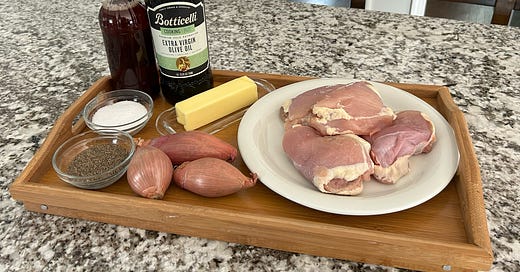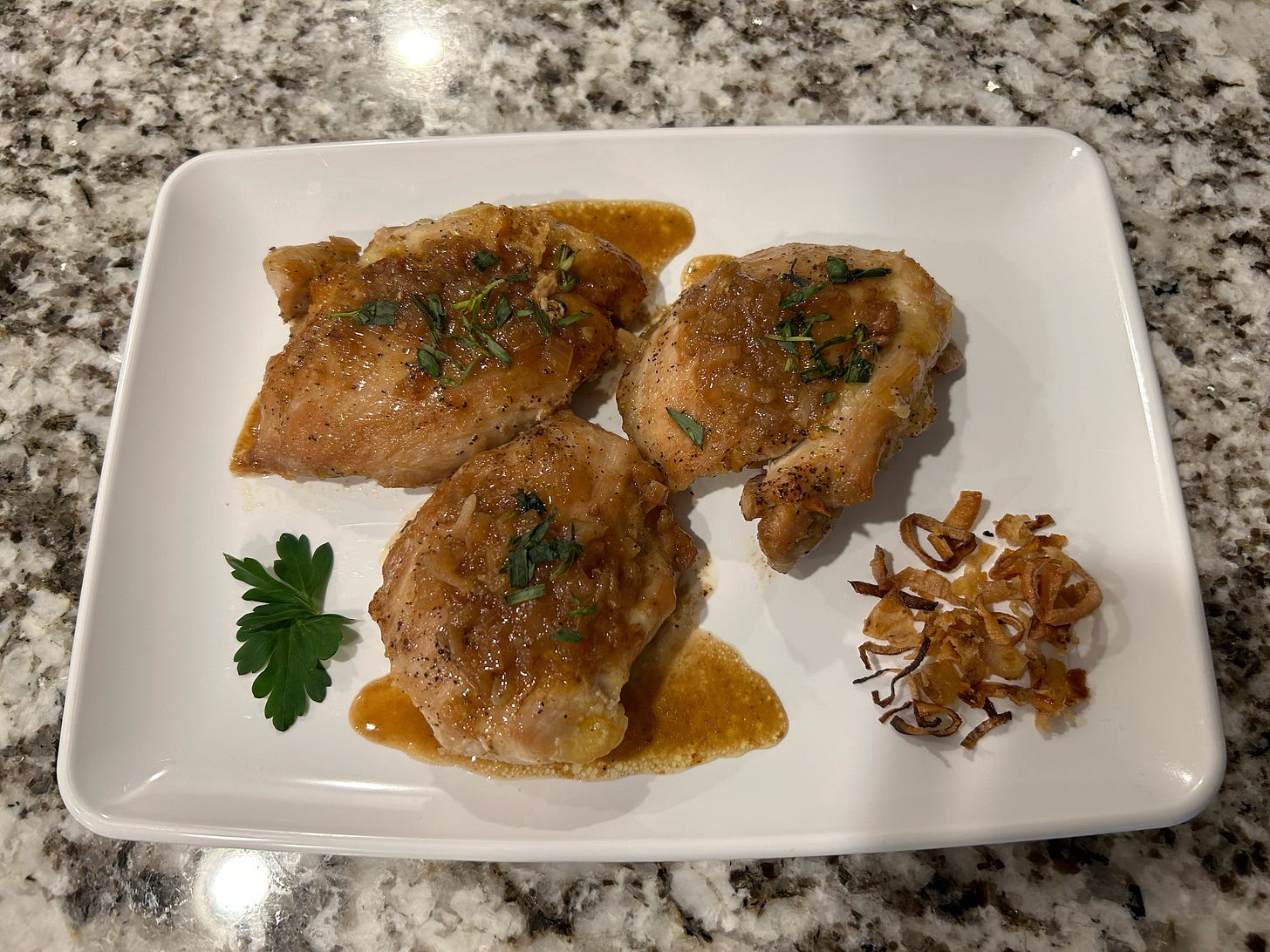"Cooking is not complicated. You have to be well organized, to remember things, and to have a bit of taste. I learned to cook by doing it, simple as that."
- Mère Eugénie Brazier
It was hard to even consider any other country for the letter F other than France, although I tried. There are only seven that I could find and I thought about digging deep in Fiji or Finland, but there really was no other option. I’ve been to France twice, first with a good friend from high school, and then with a good friend from college. Both visits were in 2016, and it’s hard to believe almost ten years have passed, especially since my college friend is no longer with us.
I really wanted to find an authentic recipe by a French chef. It’s easy to look on the Food Network website and find what you are looking for, but I wanted to find at the minimum, a French chef from France, and better yet, a woman French chef.
What I didn’t expect was to go down a rabbit hole of the origin of this recipe.
Of the five countries I’ve already done, I used ground beef and pork, so it was time for chicken to take the protein spotlight. I’ve been playing around with AI tools for a class I am taking and decided to use one of the AIs to help me do some research and practice my prompts.
I started by asking for ten of the most classic French chicken recipes. It sent back a few you would recognize, and a few that you might not. I then asked to revise the list and send me ten that didn’t include tomatoes. Poulet au Vinaigre came up in the first list, but not the second because tomato paste was included in the recipe. I was intrigued by the Poulet au Vinaigre from the beginning because a friend had sent me a similar recipe a year or so ago and I never made it. I decided this was what I wanted to make.

So I asked the AI to tell me if there was any history attached to Poulet au Vinaigre and that’s were I learned about the "Mères Lyonnaises" and Mère Eugénie Brazier. The short, short story, is that back in the 1800s (and probably even farther back) there were a group of women chefs in Lyon, France who were cooking in bistros and are essentially the cornerstone of France’s gastronomic heritage. There were a number of Mères over the years, but perhaps the most well-known - and the first woman to obtain three Michelin stars - was Mère Eugénie Brazier (1895-1977). The recipe for Poulet au Vinaigre can be traced back to the Mères Lyonnaises and I thought it was the perfect choice for all these reasons.
There is so much more the story of the Mères Lyonnaises, and it’s too long to go into here. I won’t even mention the direct line from Mère Eugénie to the NYT Cooking recipe that I reference below, but you can probably guess that other famous French chefs took from the Mères and made names for themselves on the backs of their innovation. Let’s just say that when I Googled “Eugenie Brazier Recipe for Poulet au Vinaigre” the names Paul Bocuse and Jean-George Vongerichten come up at the top of the search.
You can learn more about Mère Eugénie Brazier here and here and more about the Mères Lyonnaise here, here, and here.
Poulet Vinaigre (Chicken with Vinegar)
2 Tablespoons Olive Oil
4-6 chicken thighs (I used skinless and boneless, but skin-on, bone-in was included in many of the recipes I looked at)
Salt and Pepper
1 cup minced shallots (or scallions if shallots are not available)
1 cup good red wine vinegar
1/2 cup water
1 Tablespoon Butter
Preheat the oven to 450° F.
Heat a large skillet over medium-high heat. After 1 or 2 minutes add olive oil. When the oil is good and hot, place chicken in the skillet, skin side down if you are using skin-on. Cook undisturbed for around 3-4 minutes (until the chicken is nicely browned and releases from the skillet easily). Turn chicken and cook 3 minutes on the other side. Season with salt & pepper.
Place chicken in an ovenproof dish, put in the oven and cook for 15 to 20 minutes until almost done (juices run clear, but there is still a little bit of pink (around 150° to 155° F). At twenty minutes, turn off oven and leave the chicken in oven.
Pour almost all of the fat from the skillet - but set it aside for the second sauce recipe below - but make sure there is still a good film of oil. Return skillet to the stove and heat over medium-high heat. Add shallots, sprinkle with a little salt & pepper, stir and sauté until tender (around 2-3 minutes).
Add vinegar and turn heat to high. Cook for a minute or two. Add 1/2 cup water and cook further until the mixture is slightly reduced and slightly thickened. Add butter and stir into sauce.
Return the chicken to the skillet (along with accumulated juices) and turn the chicken in the sauce. Serve immediately.
There were a number of recipes that called for more ingredients for the sauce. I decided to keep those separate and made the second sauce while the chicken was in the oven. I used some of the pan juices from searing the chicken as a base for this one. During my initial recipe search, I wanted to find one that didn’t use tomatoes. Not that I have anything against tomatoes, but I had more of a non-red sauce in mind since the original vinegar sauce was already red-hued. I also just wanted to see how it came out without the tomato influence.
I also have a cautious nature when it comes to tarragon. I love to cook with spices from all over the world, many of which have strong flavors. Tarragon is a spice that has a very distinctive flavor. When it’s dried, the flavor concentrates its sweet, anise or black licorice a bit more than fresh. The fresh spice is a bit lighter and brighter, but can still overpower a dish if too much is used. Just a bit of caution when using it.
Here’s the second sauce:
1 medium onion, chopped
1 shallot, chopped
2 cloves of garlic
2 tbsp freshly chopped tarragon
1 tbsp tomato paste
1 cup heavy cream
2 cups chicken stock
1 cup white burgundy wine
Splash red wine vinegar
Salt and pepper to taste
Using the extra oil you set aside from searing the chicken and the cook the onion, shallot, and garlic until softened.
Add tomato paste and cook for 30 seconds. Increase heat, add vinegar, and reduce until syrupy. Add wine and boil for a minute, then add stock and reduce for 10 minutes.
Reduce heat, add tarragon. Cover and cook for 15-20 minutes. Add cream to the sauce and reduce until it reaches your desired consistency.
Serve as an alternate or a complement to the chicken.
I think if I were going to make this again, I would try chicken legs. Or maybe I would grill chicken breasts and make the sauce separately. To me, sometimes chicken thighs have a bit of a gamey taste to them. I am not sure if it was the combination of the thigh’s taste and the sharpness of the vinegar. I liked it, I didn’t love it. I did really like the second sauce though, and I could see using the second sauce on other things like shrimp of pasta. The second sauce reminded me a bit of a vodka sauce, and I would like to try it again sometime and leave out the tomato paste.
Thanks for stopping by. This installment of “Let’s Eat” is free, so feel free to share.
Enjoying kimchantment? You can also share the full site with others.
Click here for more “Let’s Eat” posts.
Join kimchantment on Instagram.
Visit the full kimchantment site.
The main recipes I used included Mark Bittman for The New York Times because it references and gives credit to Mère Brazier. For the second sauce, I used The French Cooking Academy.
© 2025 Kim Selby & Storm Your Brain, LLC. All rights reserved. All photography © Kim Selby unless otherwise credited.








